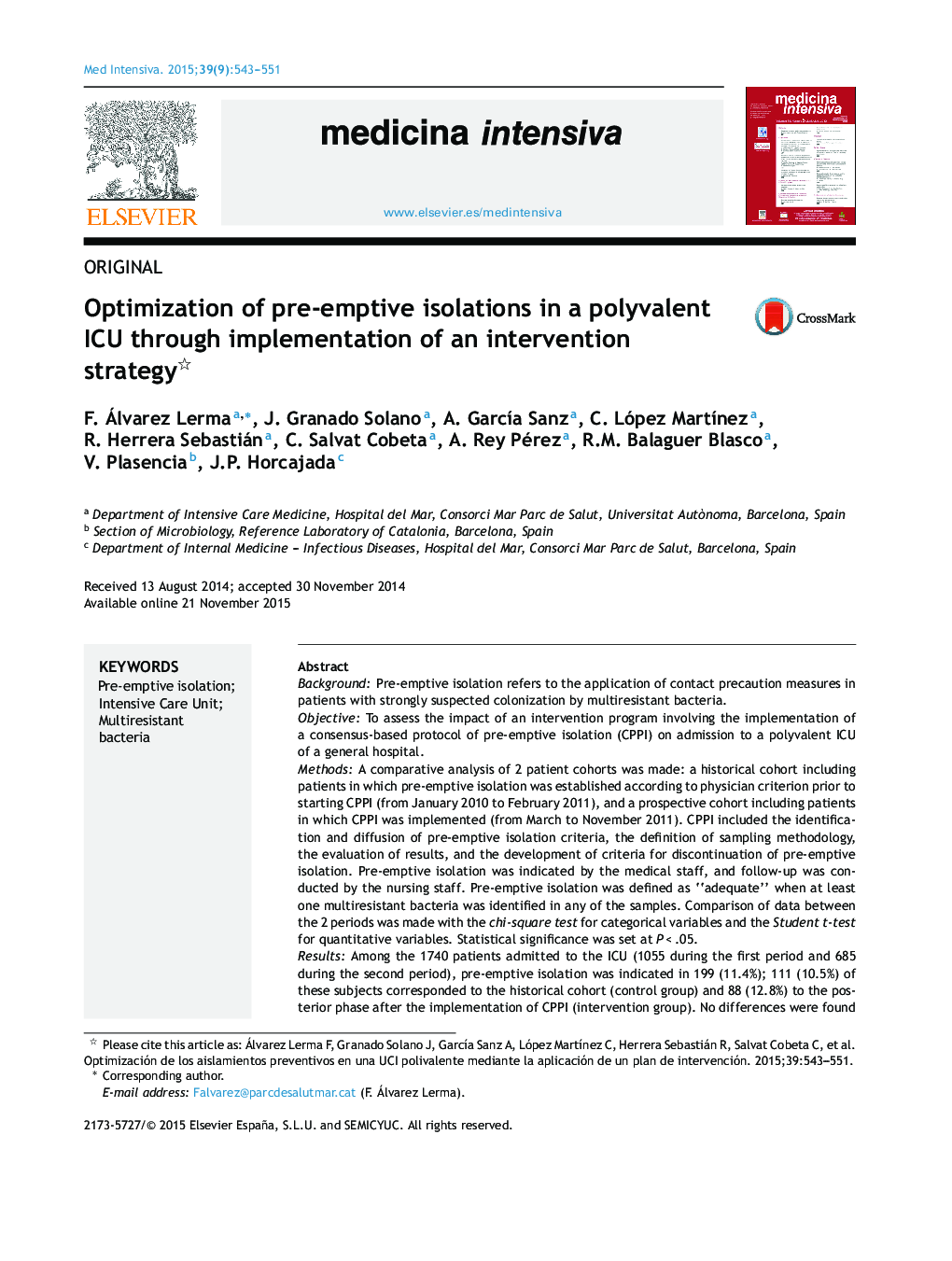| کد مقاله | کد نشریه | سال انتشار | مقاله انگلیسی | نسخه تمام متن |
|---|---|---|---|---|
| 3113978 | 1192470 | 2015 | 9 صفحه PDF | دانلود رایگان |
BackgroundPre-emptive isolation refers to the application of contact precaution measures in patients with strongly suspected colonization by multiresistant bacteria.ObjectiveTo assess the impact of an intervention program involving the implementation of a consensus-based protocol of pre-emptive isolation (CPPI) on admission to a polyvalent ICU of a general hospital.MethodsA comparative analysis of 2 patient cohorts was made: a historical cohort including patients in which pre-emptive isolation was established according to physician criterion prior to starting CPPI (from January 2010 to February 2011), and a prospective cohort including patients in which CPPI was implemented (from March to November 2011). CPPI included the identification and diffusion of pre-emptive isolation criteria, the definition of sampling methodology, the evaluation of results, and the development of criteria for discontinuation of pre-emptive isolation. Pre-emptive isolation was indicated by the medical staff, and follow-up was conducted by the nursing staff. Pre-emptive isolation was defined as “adequate” when at least one multiresistant bacteria was identified in any of the samples. Comparison of data between the 2 periods was made with the chi-square test for categorical variables and the Student t-test for quantitative variables. Statistical significance was set at P < .05.ResultsAmong the 1740 patients admitted to the ICU (1055 during the first period and 685 during the second period), pre-emptive isolation was indicated in 199 (11.4%); 111 (10.5%) of these subjects corresponded to the historical cohort (control group) and 88 (12.8%) to the posterior phase after the implementation of CPPI (intervention group). No differences were found in age, APACHE II score or patient characteristics between the 2 periods. The implementation of CPPI was related to decreases in non-indicated pre-emptive isolations (29.7 vs. 6.8%, P < .001), time of requesting surveillance cultures (1.56 vs. 0.37 days, P < .001), and days of duration of treatment (4.77 vs. 3.58 days, P < .001). In 44 patients (22.1%) in which pre-emptive isolation was indicated, more than one multiresistant bacteria was identified, with an “adequate pre-emptive isolation rate” of 19.8% in the first period and 25.0% in the second period (P < .382).ConclusionsThe implementation of CPPI resulted in a significant decrease in pre-emptive isolations which were not indicated correctly, a decrease in the time elapsed between isolation and collection of samples, and a decrease in the duration of isolation measures in cases in which isolation was unnecessary, without increasing the rate of “adequate pre-emptive isolation”.
ResumenAntecedentesEl aislamiento preventivo consiste en la aplicación de medidas de aislamiento de contacto en pacientes con alta sospecha de estar colonizados por bacterias multirresistentes.ObjetivoEvaluar el impacto de un programa de intervención basado en la implantación de un Protocolo Consensuado de Aislamiento Preventivo (PCAP) al ingreso en una UCI polivalente de un hospital general.MétodoAnálisis comparativo de 2 cohortes de pacientes, una histórica, que incluye pacientes a los que se indicó el aislamiento preventivo a juicio del médico responsable (enero de 2010 a febrero de 2011), y otra prospectiva, que incluye los pacientes a los que se aplicó el PCAP (marzo a noviembre de 2011). El PCAP incluyó la identificación y divulgación de los criterios de aislamiento preventivo, la metodología a seguir en cuanto a toma de muestras, la valoración de los resultados y los criterios de retirada del aislamiento. La indicación del aislamiento fue realizada por el personal médico, y un equipo de enfermería realizó el seguimiento. Se definió el aislamiento preventivo como «adecuado» cuando en alguna de las muestras iniciales se identificó una bacteria multirresistente. Para la comparación de resultados entre los 2 periodos se utiliza la chi cuadrado para variables cualitativas y la t de Student para variables cuantitativas. Se aceptan como significativas diferencias con p < 0,05.ResultadosDe los 1.740 pacientes ingresados en UCI (1.055 en el primer periodo y 685 en el segundo) se indicó el aislamiento preventivo en 199 (11,4%), de los que 111 (10,5%) correspondieron a la fase histórica (grupo control) y 88 (12,8%) a la fase posterior a la implantación del PCAP (grupo de intervención). No se han detectado diferencias en la edad, el APACHE II y las características de los pacientes entre los 2 periodos. La aplicación del PCAP se ha relacionado con una disminución de los aislamientos preventivos no indicados (29,7 vs. 6,8%, p < 0,001), una disminución del tiempo en la solicitud de las muestras de vigilancia (1,56 vs. 0,37 días, p < 0,001), y una disminución de la duración en días del aislamiento (4,77 vs. 3,58 días, p < 0,001). En 44 pacientes (22,1%) en los que se indicó el aislamiento preventivo se identificaron más de una bacteria multirresistente, siendo la tasa de «aislamiento preventivo adecuado» del 19,8% en el primer periodo y del 25,0% en el segundo (p < 0,382).ConclusionesTras la instauración de PCAP se han reducido significativamente los aislamientos preventivos no indicados correctamente, se ha disminuido el tiempo entre el aislamiento y la toma de muestras, además de reducirse la duración del aislamiento en los casos en que no es necesario, sin que haya aumentado la tasa de «aislamiento preventivo adecuado».
Journal: Medicina Intensiva (English Edition) - Volume 39, Issue 9, December 2015, Pages 543–551
